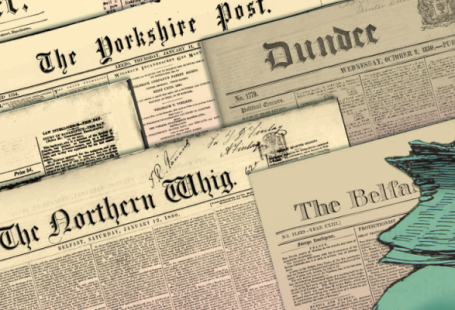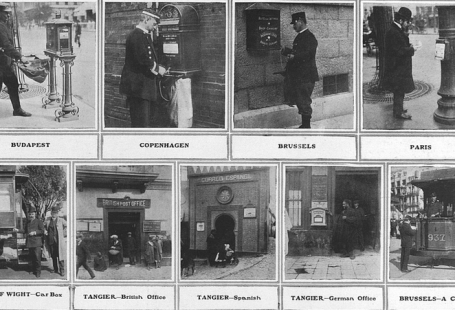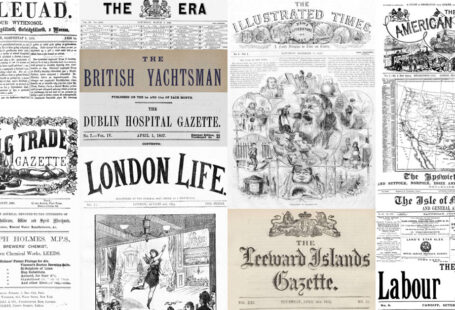What began as rumours from Spain was soon to become a nightmarish reality, as the Spanish flu pandemic began to take hold in the United Kingdom, where it would go on to kill approximately 250,000 people, and 50,000,000 globally.
Staff from the Michie Hospital | Graphic | 26 July 1919
In this special blog, as part of medicine month on The Archive, we will take a look at how newspapers from the time reported on the deadly disease, from those first rumours, to the devastation it was to cause. We will also look at how cures were advertised in the newspapers, and the speculation that was rife at the time as to what had caused it, from divine wrath to bad bread.
Want to learn more? Register now and explore The Archive
First Rumours
On 29 May 1918 the Hull Daily Mail is reporting on ‘The Spanish ‘Plague”:
Practically all Spain is affected by the mysterious epidemic resembling influenza which is raging and causing many deaths. So many workers in Government offices are down with it that public business is greatly hampered. Many private firms have had to close for want of staff. Two-thirds of the tramway staff are laid up, and the service has had to be greatly curtailed.
The article relates how there were 90,000 suffering from the ‘mysterious’ illness across Madrid, Barcelona, Saragossa, and the rest of Spain, as well as the Canary Islands. Meanwhile, the Liverpool Echo on the 30 May reports how ‘half of Parliament are down with the disease,’ with the King himself taken ill:
There is little movement in the streets… Most of the theatres have closed and half the Government staffs are laid up.
Palace of the Senate, Madrid | The Sphere | 30 October 1920
Despite Spain being in the throes of this deadly outbreak, the danger was downplayed. The Hartlepool Northern Daily Mail on 30 May 1918 carries word from the Spanish Ambassador, who was quick to allay fears by stating that ‘the epidemic which has broken out in Spain is not of a serious character. The illness presents the symptoms of influenza, with slight gastric disturbance.’
Top tip: changing terms. Whilst we call the Spanish flu a pandemic today, as it affected multiple countries and continents, at the time it was popularly called an epidemic.
Doctors elsewhere were inclined to agree. Dr. Legroux of the Pasteur Institute told the press in June 1918 that what was now being dubbed the ‘Spanish Influenza,’ due to its prevalence in that particular country, was ‘not a serious malady:’
It began at the front early in May. From Dunkirk to the Vosges most of the soldiers were attacked by it, and the Germans were not immune. It is very infectious. The infection spread to Paris, then to Spain. The Spaniards made a great fuss about it. But for that it would not be noticed to-day.
But the Spanish flu was spreading, and was soon to hit British shores.
Spanish Flu Comes to Britain
On 28 June 1918 the Dundee Evening Telegraph reports on the death of Nane Zuella, ‘a young Indian seaman,’ in Hull. The death of Nane Zuella perhaps would never reached the pages of the press, other than the fact that he died ‘from the disease popularly known as the ‘Spanish influenza.”
This was the first death from the disease reported in the city of Hull, its local newspaper the Hull Daily Mail detailing the seaman’s death and subsequent inquest, where it was determined that Nane Zuella had ‘arrived in Hull a few days go, and immediately contracted the disease.’
The docks at Hull | Leeds Mercury | 26 August 1919
But some in Hull did not view the disease as ‘serious.’ One ‘well-known East Hull doctor,’ who had been treating 100 patients a day at his surgery, was of the opinion that given ‘A few fine days…it should all be cleared away:’
There are hardly any cases showing a rise in temperature. Patients complain of pains and sore throats, but there are no complications, and the epidemic should be short, though sharp.
A fellow Hull doctor agreed; citing a certain degree of hypochondria amongst his patients:
Many people had the matter in their mind and were under the impression they were suffering from influenza.
He recommended keeping warm as a way to ‘effect a cure in a few days.’
Schools and Factories Shut
But Spanish flu was already taking its toll elsewhere in the country. The Dundee Evening Telegraph on 28 June reports on school closures in Wales, with a ‘large number of miners and others in the Merthyr district…ill with the complaint.’ In Cardiff, so many postal workers were ill that postal deliveries were affected. Meanwhile at a Belfast workhouse ‘an alarming number of deaths [had] occurred,’ with the distressing rumour that the ‘victims’ bodies turn black as coal half an hour after’ their demise. Whilst in Dudley, West Midlands, ‘scores of children [were] carried home’ after suddenly becoming infected, with many schools being closed.
The bacteria believed to cause the Spanish flu | Illustrated London News | 20 July 1918
The Hull Daily Mail, 28 June 1918, reports that Manchester had also seen a serious outbreak of the disease. Dr. James Niven, Medical Officer for the area, ‘issued a public notice giving the precautions to be taken’ in response to the situation:
1. The sick should be separated from the healthy. This is especially important in the case of first attacks in a household, factory or workshop.
2. Persons attacked by influenza should at once seek rest, warmth and medical treatment.
3. Discharges from the nose and mouth should not be allowed to get dry on a pocket handkerchief or inside the house or workshop.
4. Infected articles and rooms should be cleansed and disinfected.
5. Those attacked should not join assemblages of people for at least ten days from the commencement of an attack.
6. Special attention should be paid to cleanliness and ventilation. People should wear warm clothing and avoid unnecessary exposure.
Churches in Manchester were being ‘threatened with closure,’ with schools and cotton mills closing, and cinemas also being asked to close, although ‘they have not yet complied.’ At one munitions factory there ‘were no fewer than 500 workers absent,’ and Sunday school meetings and services were advised to take place in the ‘open air.’
Meanwhile in Carlisle, the disease was ‘rampant,’ with factory closures and ‘school children…suffering in large numbers.’ On the 5 July, the Derbyshire Advertiser and Journal reports on the situation at Derby:
There is a large number of persons down with Spanish influenza at Derby, and many of the large works in the district are being greatly inconvenienced in consequence. The victims include munition workers, tramway employees, clerks and others, and several schools have been closed in consequence of the epidemic. Doctors are experiencing a very busy time.
Divine Wrath or War Bread?
So the Spanish flu was spreading, claiming lives across the United Kingdom. And the press was quick to print speculation as to what had caused the ‘epidemic.’ The Portadown News on 29 June 1918 suggests ‘that soldiers coming home on leave may have brought it from the front,’ but its first appearance in Spain appeared to complicate this theory. Meanwhile, the same article reports how:
Others blame the war bread for the outbreak, and many, with more show of reason, attribute it to the general food scarcity and the short commons to which all have had to submit, with the consequent reduction of vitality, which weakens resistance to any epidemic.
Dundee People’s Journal | 7 April 1917
The Yorkshire Evening Post on 10 July 1918 offered a different, albeit somewhat fantastical, reason for the outbreak:
In Spain, it is stated, people say the influenza epidemic came from Heaven as a punishment to those who persisted in singing a particularly ribald song. When anybody was seized he was reminded of the fact by his friends: ‘Ah, you have sung the song!’ they said.
Spanish Flu – A Cure?
And amongst the swirling rumours as to the disease’s provenance, and its rampant spread, came the quack cures advertised in the pages of our newspapers. Some came disguised as official announcements, like this ‘Public Notice’ regarding the ‘Spanish Influenza Outbreak‘ in the Sunderland Daily Echo and Shipping Gazette:
The disease is most infectious and it is necessary that all possible precautions should be taken…one case to-day may mean a hundred to-morrow and thousands within a week. The symptoms are readily recognisable, consisting of extreme lassitude, aching of the limbs and headache. There is generally, but not always, nasal catarrh.
One might be forgiven for thinking this to be official government guidance or the like, but indeed this advertisement is peddling a supposed cure – ‘Formamint Tablets.’ These tablets apparently represented ‘the best means of preventing the infective processes,’ as well as treating those already struck with the disease.
‘Formamint’ advertisement | Illustrated London News | 7 December 1918
This was not the only product that was supposed to cure, prevent and treat the Spanish flu. There are a whole host of them advertised in our newspapers, including ‘Kue Pills,’ which could allegedly both prevent and cure the disease, as advertised in the Freeman’s Journal. You could also apparently reduce the ‘danger of infection’ by taking ‘Newman’s Fortreviver two or three times a day.’ Rich and fruity, this drink promised to ‘tickle the palate most pleasantly,’ according to the Pall Mall Gazette.
Pall Mall Gazette | 10 July 1918
Meanwhile, an advertisement under the title ‘How to Avoid Influenza‘ in the Sheffield Evening Telegraph relates how ‘Everybody is getting Spanish Influenza’ because of under-nourishment. The solution? ‘Chymol’, a ‘pure, delicious super-food‘ with ‘its red bone marrow, sweet fats, and fine Barley malt,’ which could ‘build up your natural resistance to influenza’ (Beeston Gazette and Echo).
It is no wonder that people, with the panic caused by the quick spread of this disease, turned to such purported cures and preventers, but what is remarkable is how companies took advantage of this panic in order to sell products with such baseless claims attached to them.
The Derbyshire Advertiser and Journal on 20 July 1918 pays testament to the ‘anxiety‘ that the ‘Outbreaks of so-called Spanish Influenza’ were causing throughout the country. It recommends some simple precautions, namely, keeping the ‘house, office, [and] workshop well ventilated’ and using Jeyes’ Fluid to spray ‘the atmosphere, walls and floors.’
Factory workers are given quinine to protect themselves from the Spanish flu | Daily Mirror | 8 August 1918
Also included in the press were some home remedies for the Spanish flu. The Milngavie and Bearsden Herald suggests quinine as an ‘excellent remedy,’ or using drops of oil of cinnamon ‘every two hours until the fever abates.’
Irish Independent | 13 December 1918
The Pandemic Takes Hold
By July 1918 the Spanish flu pandemic was taking hold not only of Great Britain, but countries across the world.
On 19 July 1918 the Evening Mail reports that the ‘Spanish variety of influenza is spreading with alarming rapidity among the Swiss population.’ There it had seen high mortality rates ‘among persons with unsound lungs,’ with ‘men between the ages of 20 and 40’ being generally attacked. Cases in the Swiss Army numbered 7,000, schools were closed, with ‘the telegraph and telephone services…suffering greatly.’ The municipality of Môtiers, Val-de-Travers, saw 400 struck with the illness out of a population of 1,100.
Meanwhile in the Scottish town of Kirkintilloch, the Spanish influenza is described as being ‘very rife,’ with ‘quite a number of people [having] come back from their holidays only to take to their bed.’
And then by the end of August, the disease ramped up once more, representing Spanish flu’s second wave.
By September 1918 Sweden was again facing the ‘Ravages of Spanish Flu,’ as reports the Birmingham Mail, its voracity impacting infrastructure in that particular country:
At present quite 50,000 persons are suffering from the disease, and during the last two weeks about 700 people have died through it. Whole cities are suffering, and in many places it has been found impossible to save the harvest.
In October 1918 Hungary was badly hit, the Aberdeen Press and Journal reporting how there were ‘over 100,000 cases of Spanish influenza in Buda Pest, and there have been a great number of deaths.’ Meanwhile, the Liverpool Echo detailed on 8 October 1918 how ‘180,000 new cases’ were reported in the German Army.
City of Budapest | Graphic | 9 December 1911
Iceland was to suffer too, the Westminster Gazette revealing how, in November 1918, ‘about two-thirds of the inhabitants of Reykjavik are suffering from influenza, and in many families every member is ill.’ Newspapers went unpublished, and post offices and banks were only open for two hours every day.
Closer to home, the ‘influenza epidemic’ had yet to reach its height even in November 1918. The Westminster Gazette on 13 November reports on 7,560 deaths in England and Wales during the previous week. Particularly badly hit were West Ham, with 223 deaths, Sheffield with 402, Dublin with 204 and Leeds with 247.
Contemporary chart comparing the 1665 Plague to the Spanish flu | The Sphere | 21 January 1921
New Theories
And as the pandemic continued unabated, new theories and cures were put forward. Italian doctor Professor Ciauri, director of the military hospital in Cotrone, blamed the disease’s introduction into Italy on ‘prisoners returned from Austria,’ according to the Westminster Gazette in September 1918. Meanwhile, ‘a serious outbreak’ in South Africa was blamed on ‘recent arrivals from England.’
In April 1919 the Aberdeen Press and Journal presented ‘New Theories from Sweden’ regarding the Spanish flu. This idea that the movement of people contributed to the disease’s spread was affirmed, many doctors claiming to have ‘proof that Spanish influenza is mainly spread along the routes of communications, railways, and country roads.’
‘First Map of the Great Influenza Outbreaks of 1918-19’ | The Sphere | 20 March 1920
The idea that the disease ‘attacks mostly the strong’ was also investigated. Whilst Swedish doctors concurred that ‘most victims are persons aged between 20 and 40,’ the highest mortality was to be found amongst ‘ill-nourished families,’ and particularly ‘industrial workers.’
These doctors also put forward an interesting notion regarding the prevention of the disease – the consumption of alcohol:
Many reports confirm the popular doctrine that heavy spirit drinking is a preventative, and one doctor says that the war restrictions on sale of spirits are a cause of the widespread nature of the epidemic, and adds that had complete prohibition prevailed during the last year the mortality would have been much heavier than it has been.
Another Swedish doctor, one Dr. Bjoernson from Stockholm, put forward his own idea for a cure, as detailed in the Westminster Gazette:
This comprises the exposing of the patient’s back to a strong electric heat and light appliance, followed by the application of heat-developing compresses, whereby an intense perspiration is induced. Dr. Bjoernson is able to claim that all his numerous patients who have been subjected to this treatment have been cured within two to five days.
Finally, another ‘prominent Stockholm doctor expressed his conviction that in the coming year we shall have a series of influenza ‘after-epidemics” – a conviction that was to be borne out.
It Continues
With the new year of 1919, still the Spanish flu pandemic did not relent, the disease moving into its third wave. The Scotsman reports in January 1919 that ‘Spanish influenza is raging violently among the Allied soldiers encamped near Copenhagen.’ By February 1919 the Lancashire Evening Post reports how ‘Spanish influenza has seized Vienna in its terrible grip.’
A Vienna street scene | Leeds Mercury | 28 February 1911
40,000 people had been taken ill with the disease, and ‘Hospitals [were] choked to overflowing with sufferers.’ Most morbidly, tramcars had been transformed into hearses to accommodate the dead:
A special all-night service of electric ‘coffin cars’ has been inaugurated in Vienna. These are ordinary tramcars which have been converted into hearses, each holding 32 coffins. These coffin cars collect the dead from the houses and convey them direct to the cemeteries.
By May 1919 ‘the Spanish influenza [was] raging with renewed violence in Petrograd and Moscow,’ as reports The Scotsman. And many months later, in January 1920, the Dublin Evening Telegraph carried the news that ‘thousands of cases’ were being reported from American cities, the fourth wave of the pandemic.
The scene in an overcrowded American hospital | Irish Independent | 2 May 2009
In Chicago, 2,514 ‘fresh cases of influenza’ were reported in one day, with health officials asserting ‘that the epidemic has now reached its crisis.’ News from Washington revealed that army camps, especially those in the Mid-West, had been hit by the disease.
But, by April 1920, came hope. The Spanish flu pandemic which had swept across the world relented, the danger passed. But the tragic legacy of the outbreak, the unbelievable stain of mortality that had wreaked such irreparable damage, was complete. It had taken more lives than the First World War, it had killed indiscriminately, but, at last, it had ended, these newspaper extracts providing just a snapshot of how the Spanish flu swept the world, and changed it forever.





















